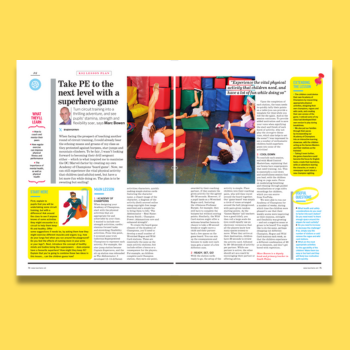PE curriculum – How to ensure yours is ready for an Ofsted deep dive

Dive in headfirst and ensure your PE curriculum is top-notch and Ofsted ready, says Felicity Gardiner…

“We’ve chosen to have a deep dive in PE.”
It was day five in September when we got the call, and heard my principal utter those dreaded words. I immediately launched into panic mode.
Once the initial thoughts of “How do I do this?” and “Do I know enough?” had passed, I set about getting myself prepared (well, as best I could with half a day’s notice).
I took over as sport and PE lead at my school in 2016 when we underwent academisation.
It was a challenging time: half of our PE was being delivered by external agencies and the subject was a very low priority in school.
My journey started at a PE network meeting. I felt totally inadequate compared to other leads – they were offering so much more and all seemed to know what they were talking about. However, rather than feeling downhearted, I came away really inspired by what could be achieved.
Fast forward a few years and I’m extremely proud of what we offer our children in terms of PE, physical activity and school sport.
Three ‘I’s
When it comes to being deep dive ready, the three ‘I’s are huge: intent, implementation and impact. When considered carefully, they give you a tailor-made offer to suit the needs of the children in your school.
First, when thinking about intent, consider if your curriculum is ambitious for all learners and enables them to make good progress. Having a clear vision of what you want your children to learn and achieve across the school is vital.
We worked hard to create ours, collaborating with all stakeholders to gain their insight into the outcomes we wanted to achieve. Even if you only have an evening’s notice, you can brainstorm all the ways PE contributes to your school and list the things your children gain from it.
For example, we wanted all of our leavers to experience and develop the skills of leadership. We achieve this via our ‘active lunchtimes’ scheme, guided by play leaders, and our range of sports teams that represent the school. It’s important to have your vision at the forefront of your mind when talking to inspectors.
Implementation is where a strong curriculum really comes into play. My long-term plan proved a useful talking point during discussions with the inspector, so have yours ready.
You need to ensure that there is coverage across all year groups so that the skills you want to be developed can build on prior knowledge. Whether you buy in a scheme or have developed your own long-term plan, it’s important that teachers have the subject knowledge to teach the subject well.
I carry out annual audits of colleagues’ needs and develop a programme of CPD to support the effective delivery of PE. If you use coaches, make sure you have a clear idea of what is being taught and how.
With impact, the most important thing to know is that your children are making progress. You need to be able to give your rationale for whatever method of assessment you use.
We don’t use formal assessments such as completion of skills grids, but we informally RAG rate key skills for units that, when layered, give a good picture of the ability of children.
Impact is not just about the curriculum though. PE offers so much more with regards to the impact on a child’s health and wellbeing. Consider how you can provide children with life skills so that they can grow into healthy and active individuals.
Whole child
Most importantly, think about the impact your PE curriculum has on the whole child, and all those little things that PE offers that other subject areas can’t. This proves crucial in making your school unique.
The emotional health and wellbeing of children is a huge thing to consider in current times and PE can provide you with the tools to support children in very unsettling circumstances.
We had a big push on mindfulness, relaxation and regular ‘brain breaks’ to help ease pupils back into school life post-lockdown. Consider what you do in your school, whether that’s yoga, colouring club or giving children opportunities to be play leaders or sports council members.
Share the community activities you take part in that give children a sense of belonging, whether it’s a themed week, Santa dash with the PTA or your May Day festival.
During our deep dive, the inspector invited me to a short 30-minute interview alongside my curriculum lead.
We conducted informal observations of the PE going on in school, focusing on my perception and judgement of PE. This was followed by conversations with a group of children selected by teachers from the sessions observed.
Discussions were also held with the observed teachers and the inspectors were particularly keen to speak to our NQT.
As a school we’ve been awarded the afPE Quality Mark, School Games Gold Mark, Youth Sport Trust Gold Quality Mark and were Midlands winners in the Sport and PE Premium Funding Awards. Working towards these accreditations required a long hard look at all aspects of our PE curriculum and whole-school offer. It gave me experience in sharing our successes with visitors.
I’d really recommend applying for some awards and carrying out a thorough self-evaluation to help you know the bones of your subject.
How effective is PE in your school?
Use these questions, compiled from my deep dive experience, to focus your preparation.
1 | Can you describe PE provision in your school?
Have a vision document ready to share with the inspector. Alternatively, brainstorm all the things PE offers in your school and have this to hand. Share your long-term plan. Plans for PE and Sport Premium should be on your school website so the inspectors may have already looked at this prior to your visit.
2 | What is the progression of skills like?
Talk about how your long-term plan was designed. Share examples of medium-term planning and assessment documents to help explain your intent. Discuss how specific skills are built upon over the Key Stages and year groups.
3 | How do you know children have made progress?
Discuss your methods for assessment You need to have good knowledge of the skills and capabilities of both staff and children within your school in order to be confident when talking about progression.
4 | What support do you give to staff members?
Share the CPD opportunities available to your staff and how you decide what training is required. Talk about the impact that staff training has had.
5 | What makes your PE curriculum different?
Explain how your curriculum came about. Was it designed for or by children? If you have units that your children specifically chose, talk about how these were implemented. Tell the inspector about events or activities over the school year that help inform your curriculum.
6 | What is physical activity like over the school day?
Share any active learning in the curriculum that goes on in your school. Talk about initiatives you have taken part in as a school to promote health and physical activity, such as Bikeabililty.
7 | How does PE support other subjects?
Think about the opportunities for active learning and how it supports learning in core subjects. Talk about any collaboration across subjects. For example, I worked closely with our science and PSHE leads when developing a fitness unit for PE and am now working with our geography lead to improve our teaching of orienteering.
Felicity Gardiner is PE and sport lead at John Wheeldon Primary Academy in Stafford.












